Blog
April 28th, 2010
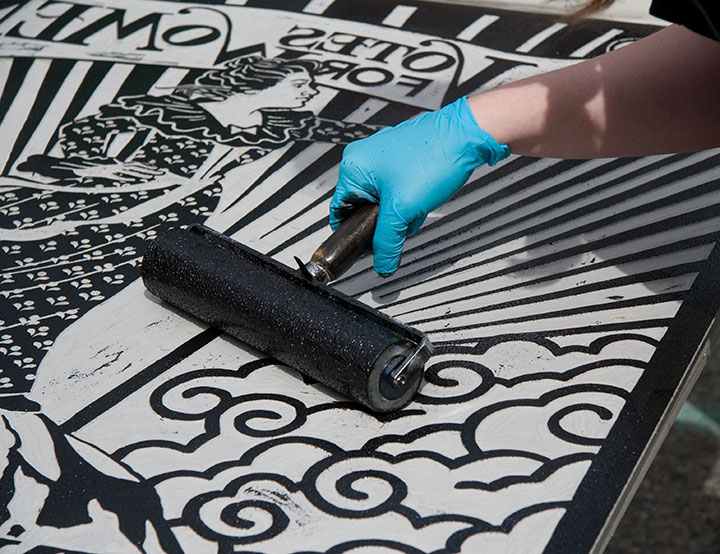
Inked up,
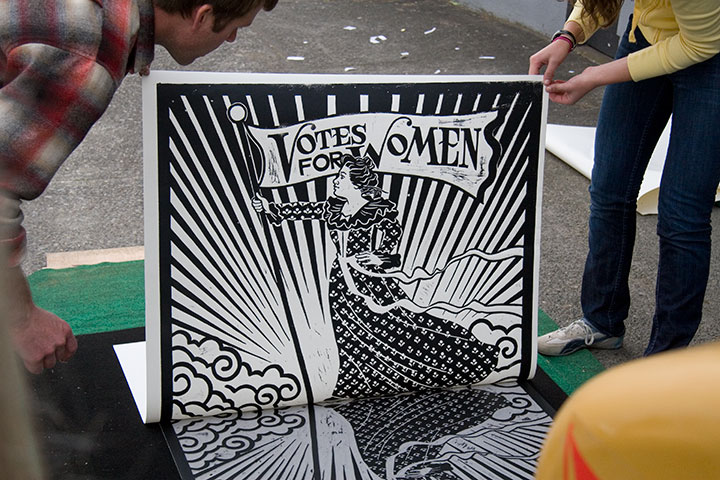
hand-pulled,
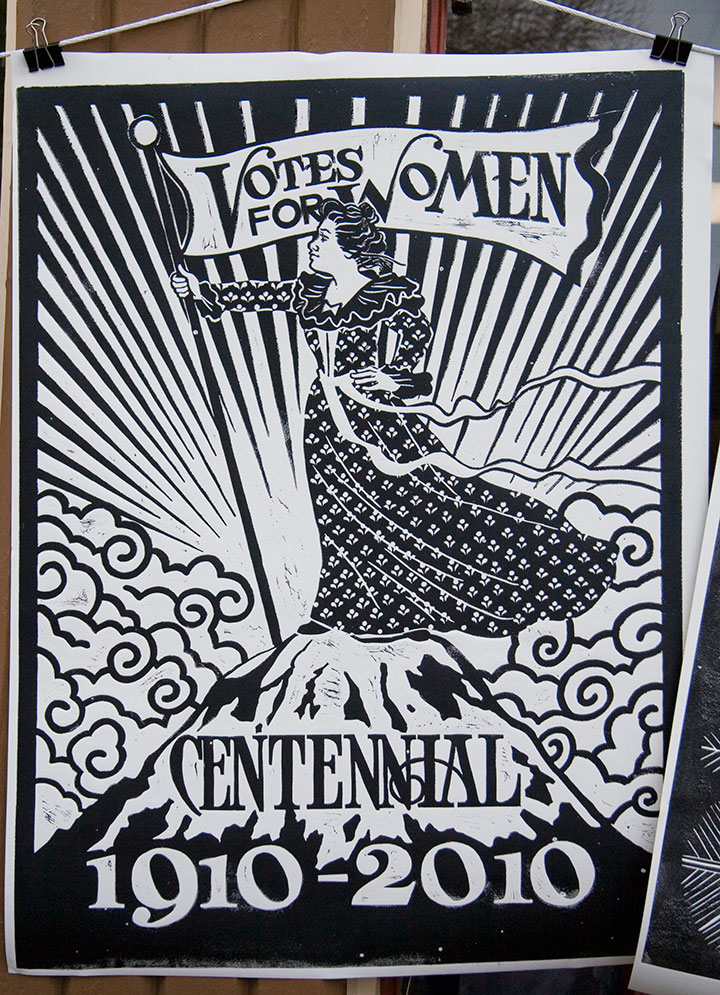
and voilà! Our second collaborative steamroller print, an unofficial Dead Feminist, inspired by Cora Smith Eaton King, who in 1909 climbed Mt. Rainier with a party of Seattle Mountaineers and placed a “Votes for Women” banner at the summit.

This year’s Wayzgoose was the biggest bash yet! We had all the regulars—
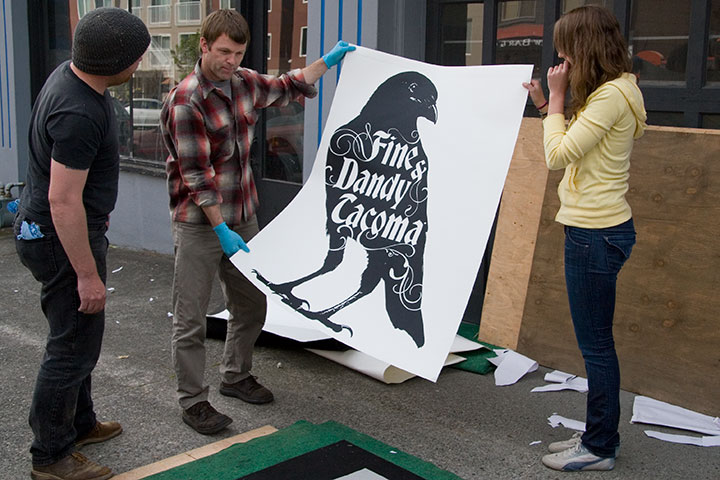
who churned out perfection under pressure (no pun intended)—
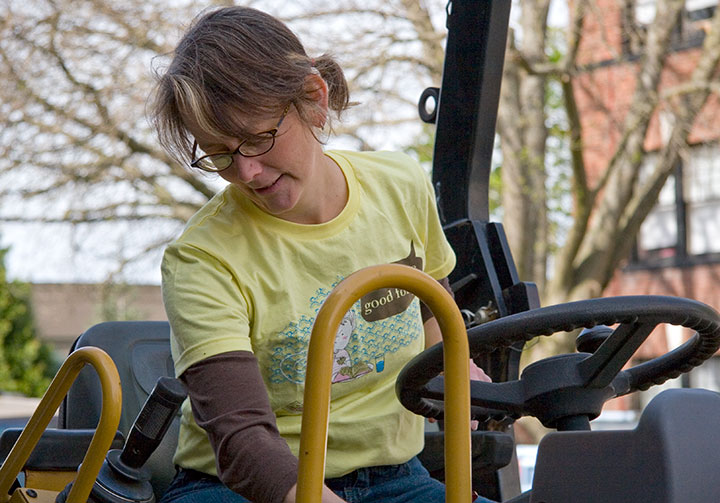
our beloved ringleader,

a certain befezzed flavor,

and a whole host of newcomers to round out the experience.
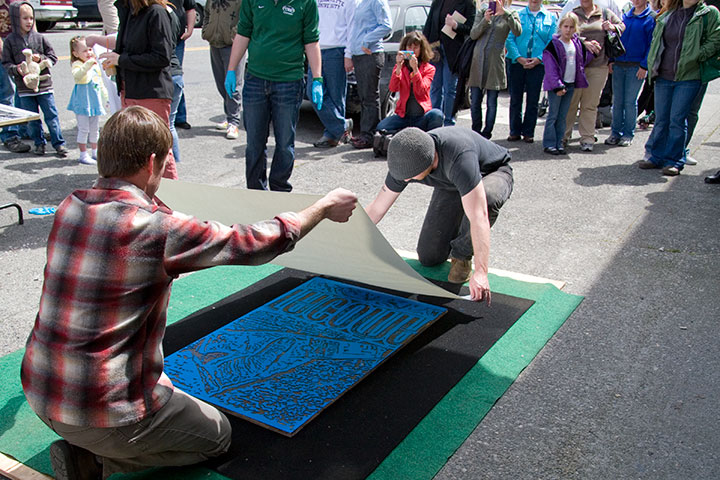
We had an enormous crowd (thank goodness for the good weather!),
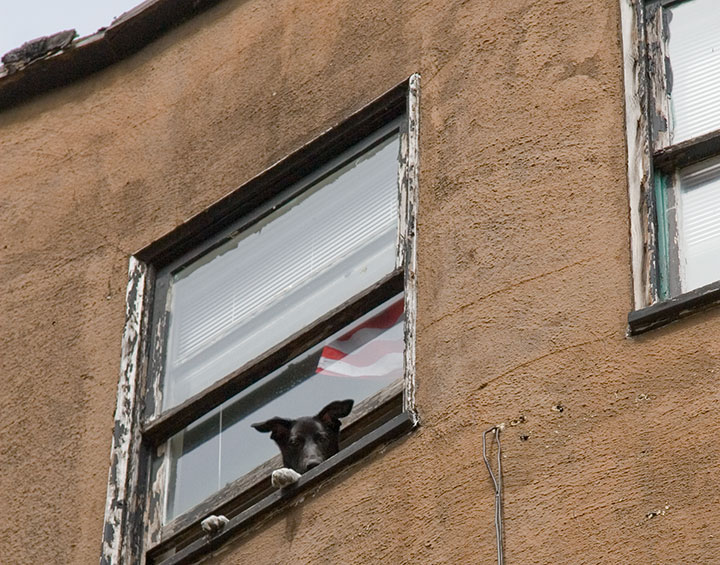
and even a few unexpected audience members.
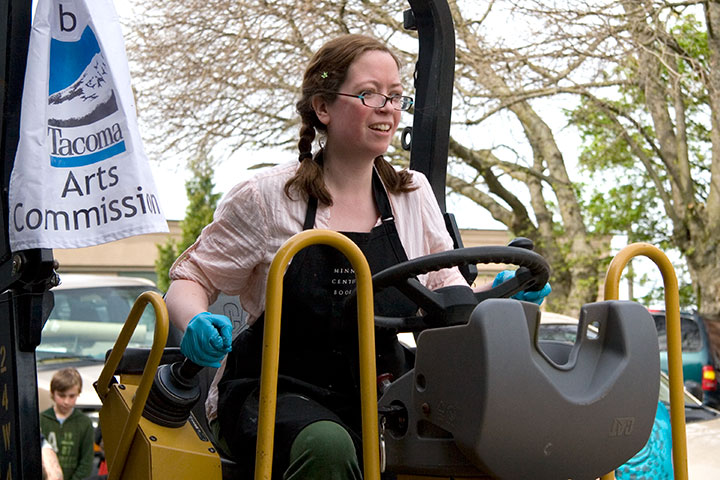
This year I got to try my hand at driving the steamroller,
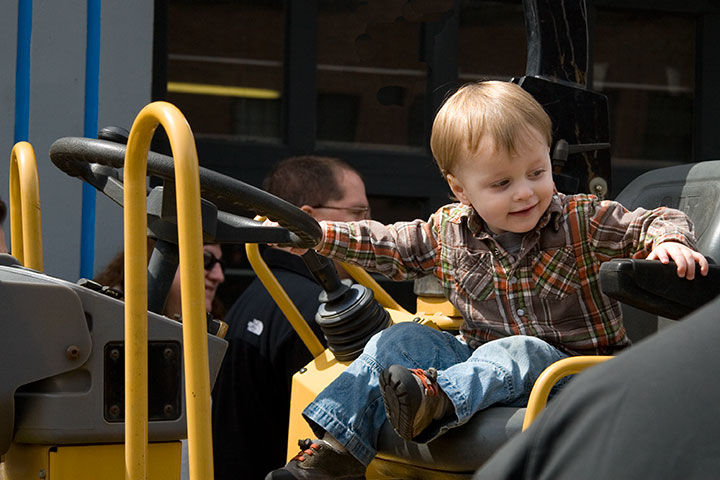
but I think pretending was plenty enough for this little guy.
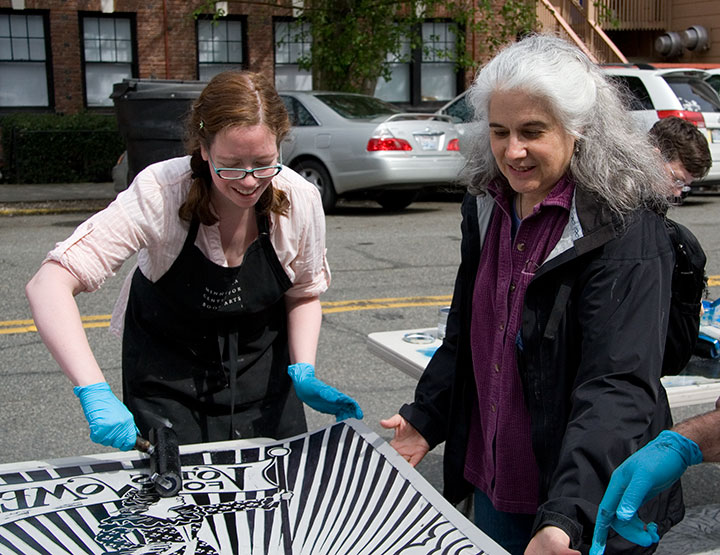
Thanks to everybody who stopped by to say hello, or stuck around to lend a helping hand.

And of course, a huge bucket of gratitude to the Tacoma Arts Commission for making it all happen!
One more acknowledgement: photography by Michael O’Leary. Thanks, Dad!
April 18th, 2010
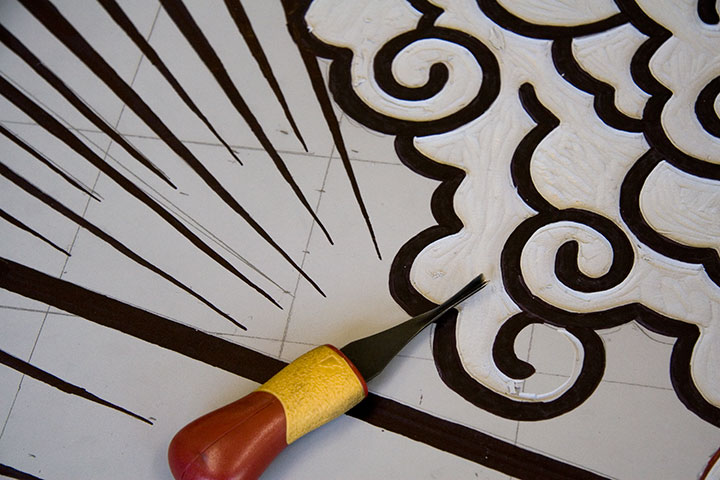
Jessica and I are carving like mad this week, getting ready for some quality steamroller time.
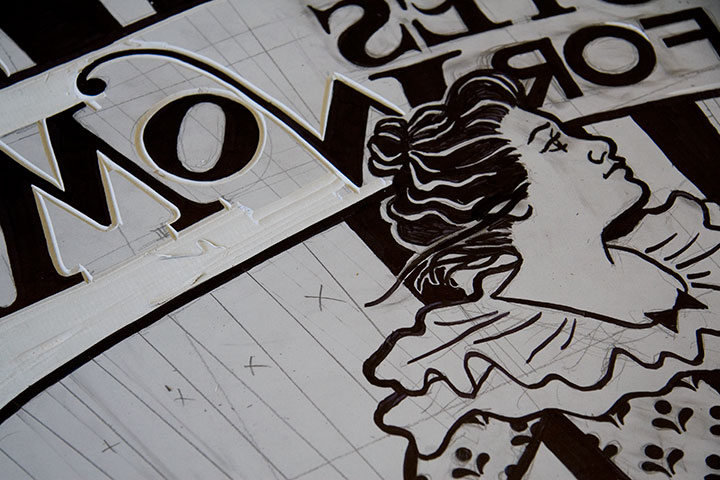
Next Sunday, April 25, is the sixth-annual Wayzgoose at King’s Books, right here in Tacoma. This year promises to be the biggest hullabaloo yet, with letterpress magnetic poetry, B.Y.O. t-shirt printing, papermaking demos, artist tables, and the star of the show: steamroller printing! Last year over 500 people came to check it out, despite a torrential downpour—and this year, the weather just might promise to behave, so we’re bracing for a mob. There’s a reason for the crowds: this is a heckuva lot of fun. Here’s the skinny:
6th Annual Wayzgoose!
Sunday, April 25, 2010
Noon to 4 pm
Free!
King’s Books
218 St. Helens Ave., Tacoma
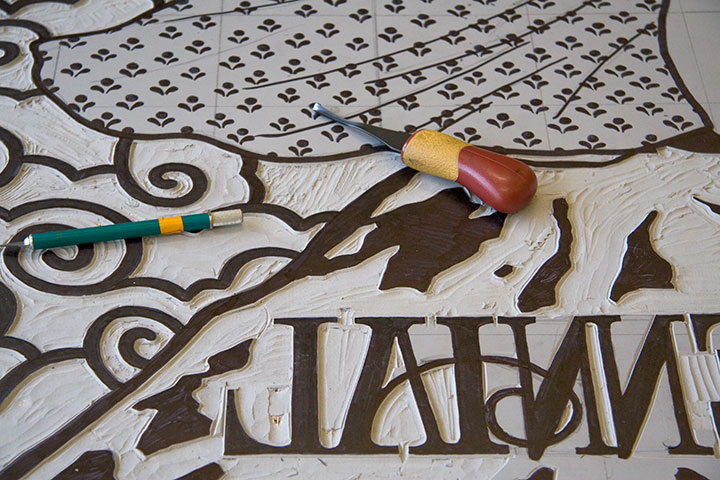
Eight artists and artist-teams will be printing gigantic three-by-four-foot linocuts in the street, including Jessica and me—we’ll be adding another unofficial Dead Feminist to our roster. (Take a gander at our last steamroller print here.) This is just a sneak peek; stop by next Sunday to see this block in action.
See you there!
March 6th, 2010
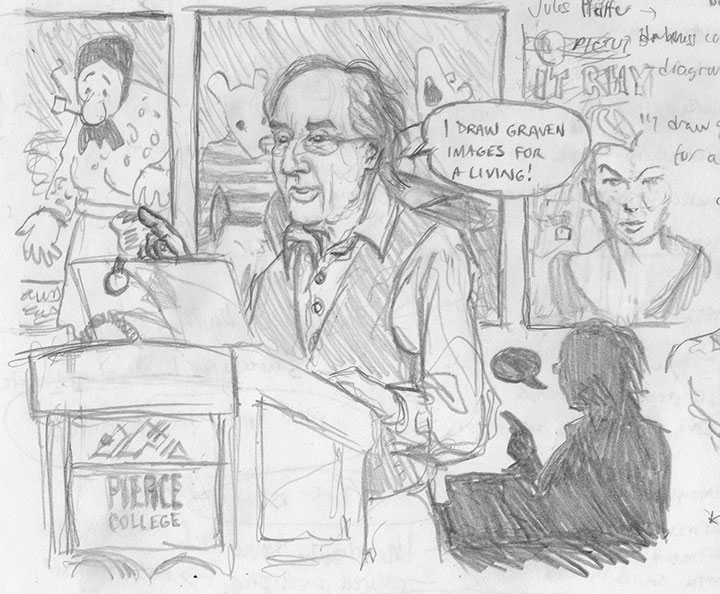
The other night I went to a talk by comics artist Art Spiegelman, and as usual, brought one of my trusty sketchbooks with me. Since comics and I go way back, and I’m a big Spiegelman fan, I think I got a little carried away with the doodles accompanying my lecture notes. I was a little abashed when the people next to me noticed and commented; all I could say was, “I do this a lot—it helps me remember.”
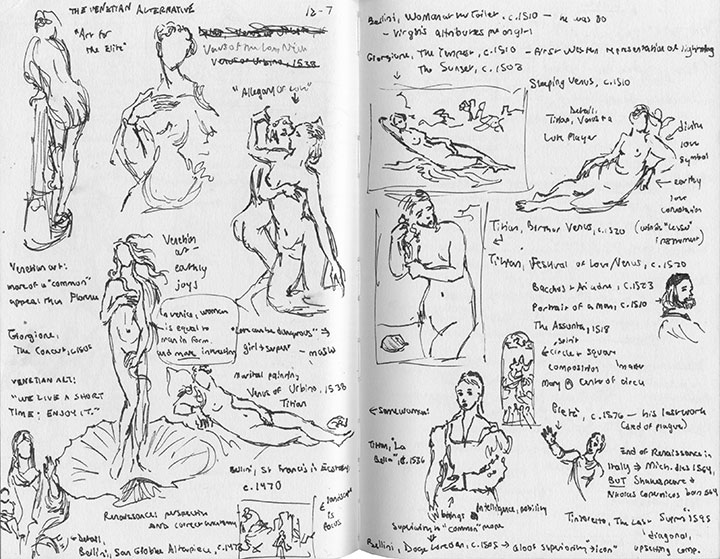
I’ve always been an obsessive note-taker, but I discovered in college that adding sketches to my notes went a long way towards my good grades in art history (this must have been the “Naked Ladies of the 15th and 16th Centuries” lecture or something).
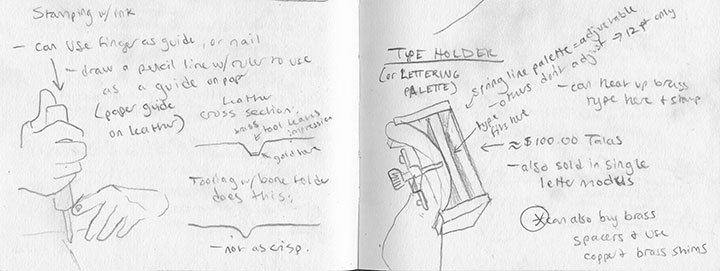
Then when I fell in with the book arts, drawn diagrams were a godsend for remembering complicated equipment and technical processes.
By the time I graduated, the habit was ingrained. I found not only that drawing was an excellent memory trigger, but also helped me focus on the moment at hand.
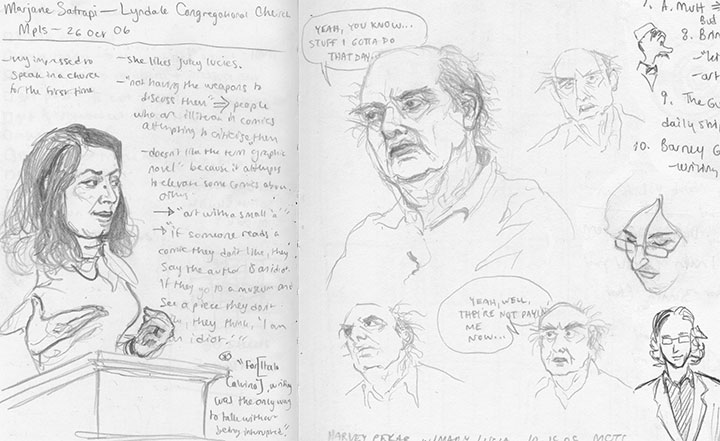
The comments on my Spiegelman doodle reminded me that I had a funny habit of drawing comic artists and writers (from the left, Marjane Satrapi, Harvey Pekar, David Mazzucchelli)—and often portraying them as comic-book characters themselves. As I dug through something on the order of fifteen sketchbooks to find my grumpy Pekar sketches, I unearthed scores of these things, from all manner of locations and events:
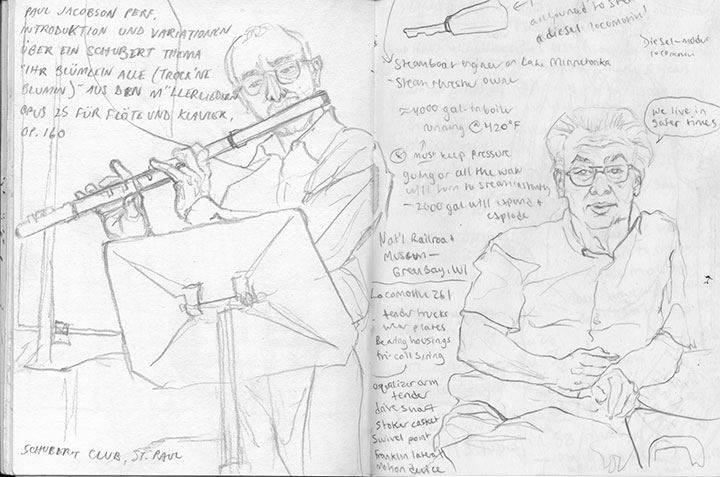
classes, performances and lectures;

public transit and airports—
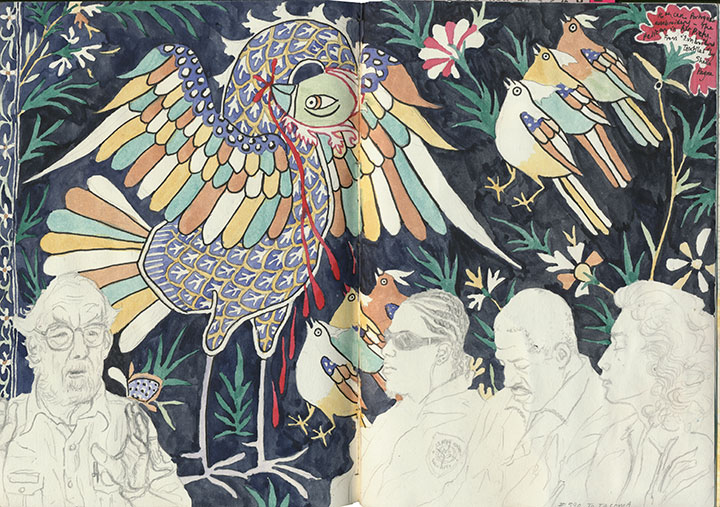
—among other things—
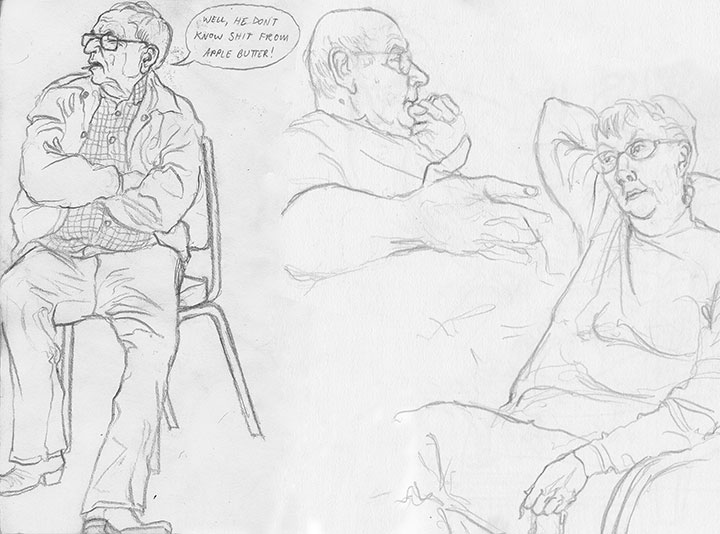
family gatherings (yes, I quoted the above verbatim; that’s the Tailor’s uncle, and he’s comedic gold);

work meetings;
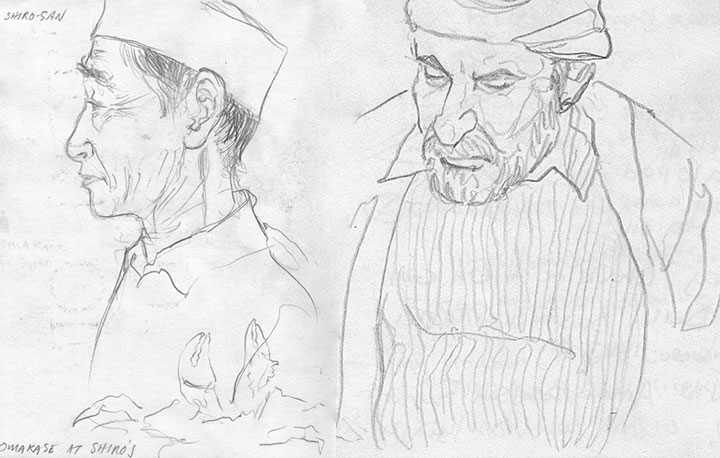
restaurants, coffee shops;

wedding receptions;
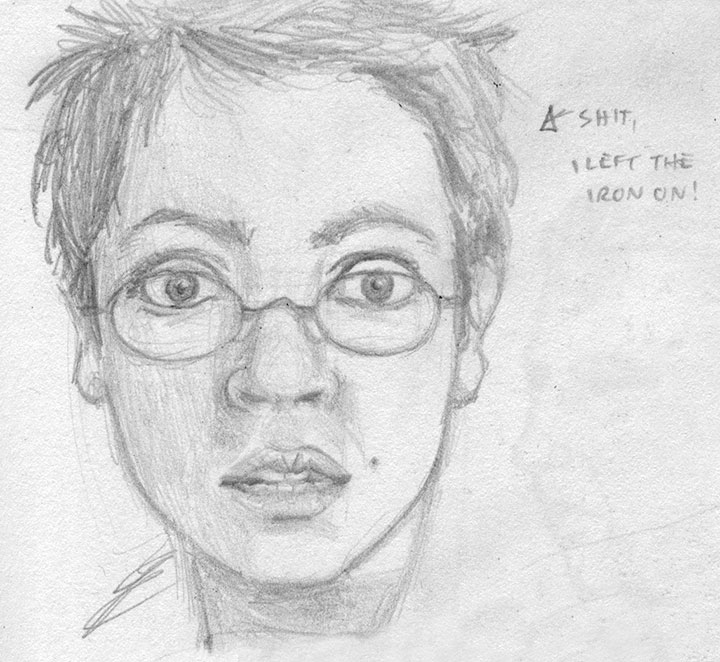
and even my own mirror, when I’m working alone (that one’s an oldie from college).
I draw when I’m trying to document an event, when I’m nervous, when I encounter a particularly unusual face, when I’m telling a story of an odd person I saw that day, when I want to preserve a loved one, and even when I’m not really aware of it—I found plenty of sketches that I had no memory of making.
Maybe there’s some psychological disorder that lists obsessive and semi-conscious sketching as a symptom, but this is one compulsion I’d like to hold on to. I know I spend more time drawing the speaker than taking actual notes, but if I remember the content just as well, I suppose it all comes out in the wash. Besides, I can’t possibly be the only one who does this, right?
Right?
January 30th, 2010
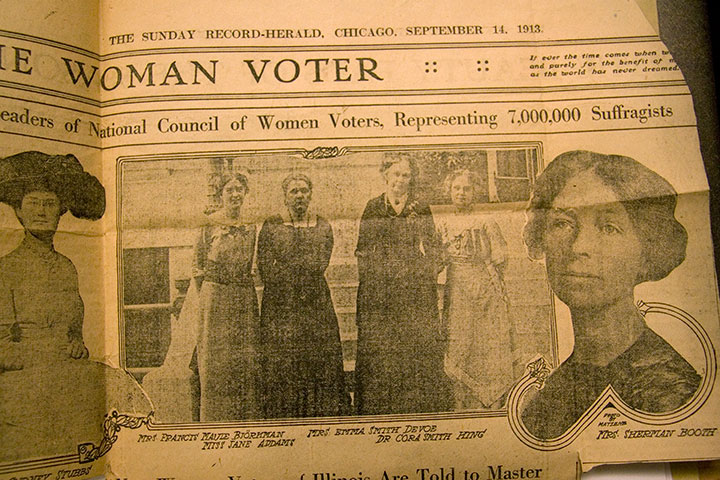
It’s just about that time again: Jessica and I are working hard on the next Dead Feminist broadside. She’s poring through texts and historical facts, and I’m pencilling as fast as my tendonitis will let me. This time we’ll be unveiling the new piece at the Washington State Library near Olympia; the staff invited us to give a lecture about the series next month.
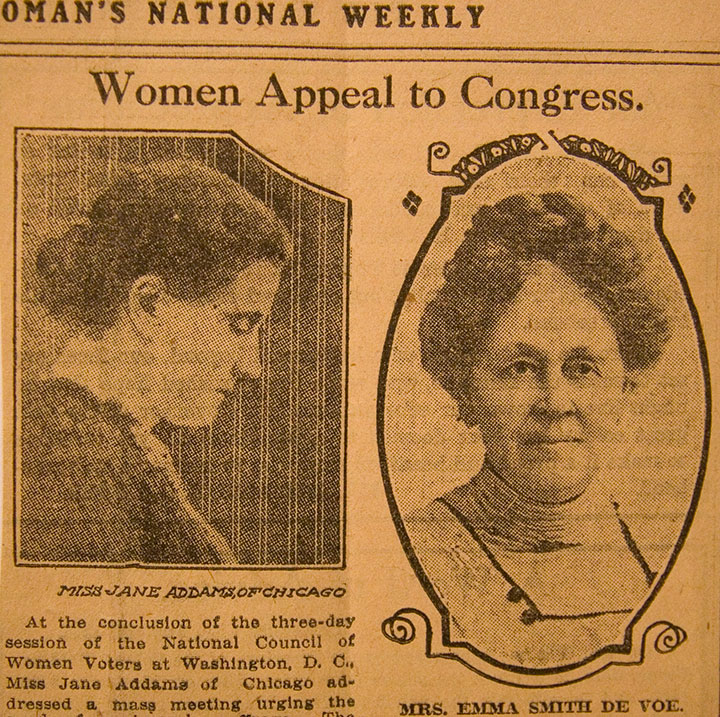
The library boasts the entire collection of letters and personal papers of Emma Smith DeVoe (pictured above, right), women’s rights activist and leader of the Washington suffragist movement. And since this year marks the 100th anniversary of women’s suffrage in Washington, we figured Emma would be a perfect fit for the new piece.
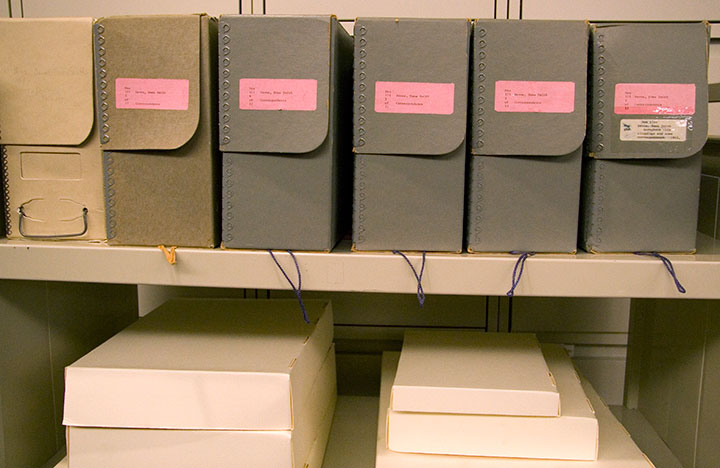
So a couple of weeks ago, Jessica, Zooey (R.I.P., J.D. Salinger) and I took a field trip to visit the archives and conduct a little research. When we arrived, we realized what they meant by “collection:” twelve enormous boxes packed full of letters, clippings and souvenirs. A “little” research obviously wasn’t going to happen.
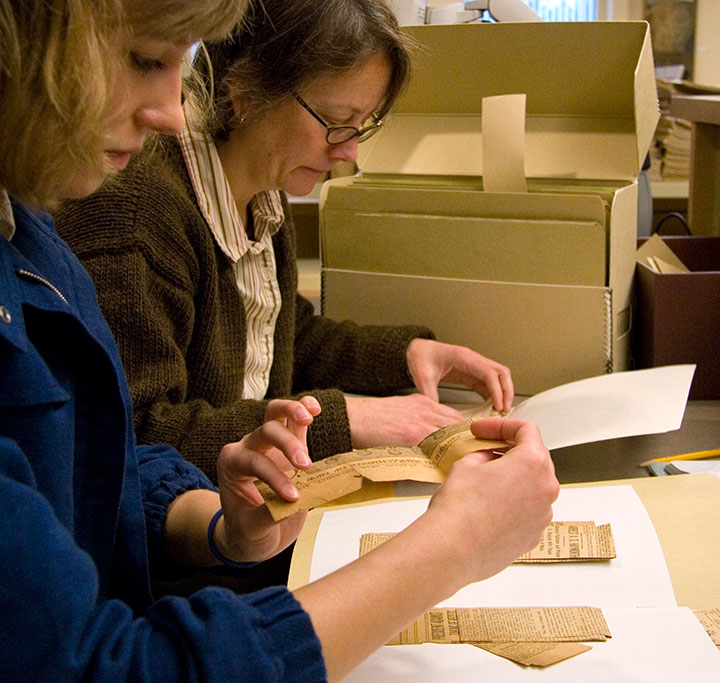
Luckily, the incredibly knowledgeable and helpful library staff (thank you, Sean!) let us take as much time and as many photos as we needed. So we cozied up to a work station and dived in, one box at a time. Together we went through literally thousands of pieces of paper.
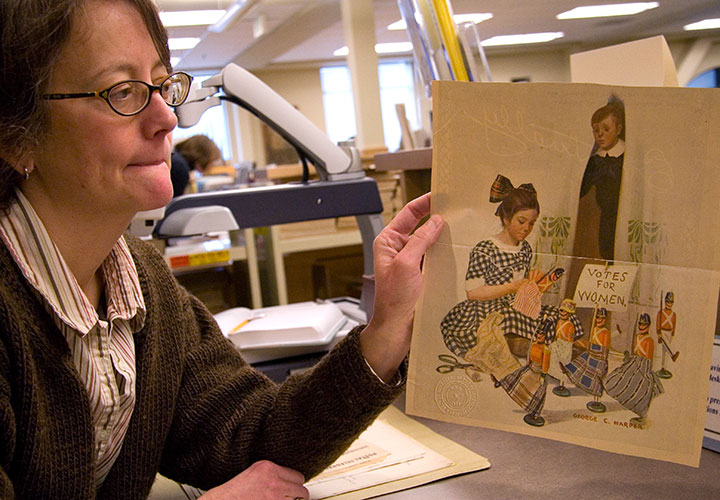
What we found was a fascinating collection of souvenirs, business cards, newspaper clippings,

leaflets and other propaganda,
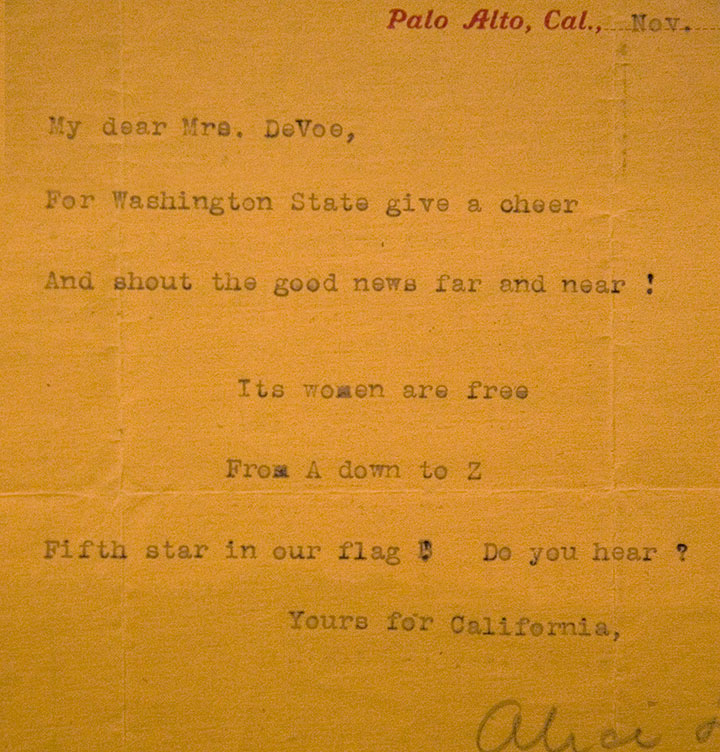
fan letters (Emma had an impressive array of admirers),
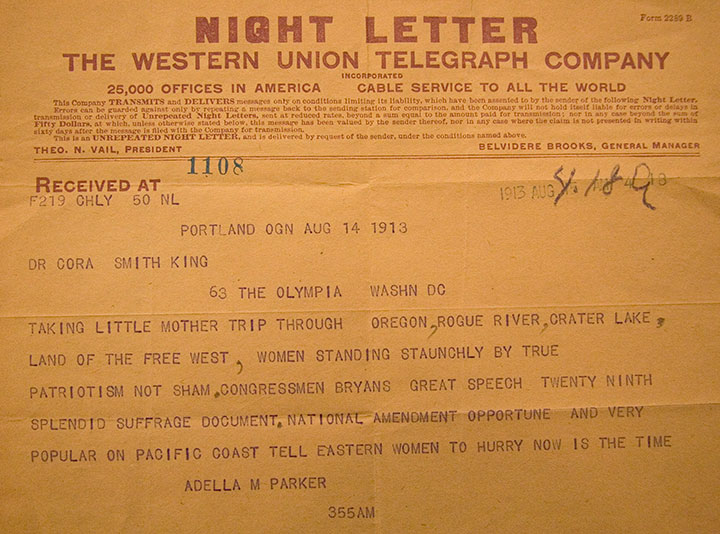
telegrams, notes from sitting U.S. senators and presidential aides, and reams and reams of correspondance between the members of the Washington suffragist movement.
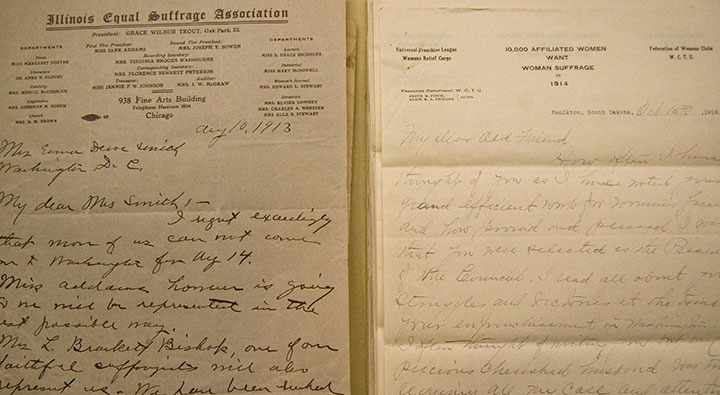
The trouble was, most of these documents were utterly mundane—letter after letter simply acknowledged receipt of previous correspondance, or gave detailed instructions for planning events and delegating tasks. Worst of all, Emma rarely made carbon copies of her half of the correspondance, so there was very little in her own voice.
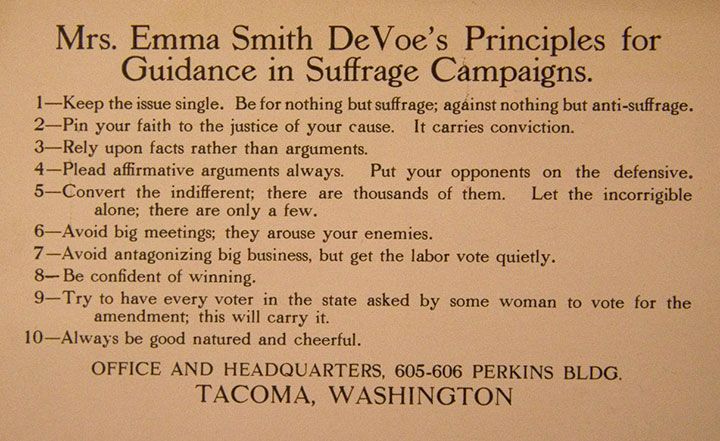
We spent nearly four hours poring over every folder and box, and the only potential Emma quotes we found were mined from this instructional card. Still, it didn’t feel like we had found our inspiration—just a few weeks from our talk, we had no quote and no social topic for the piece.
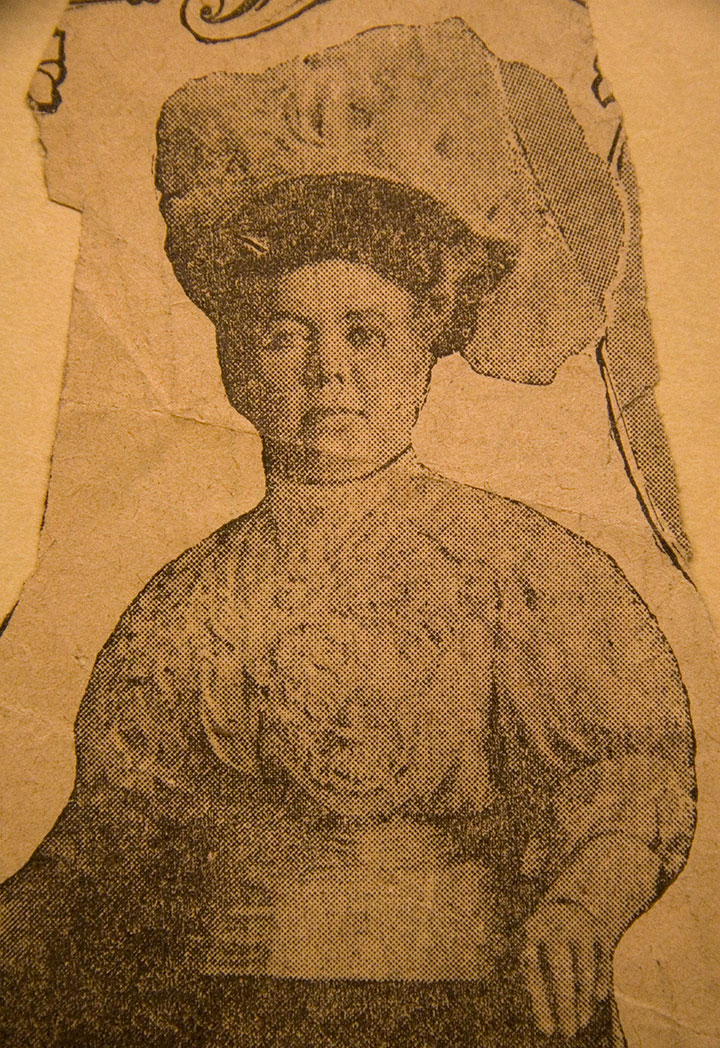
What we did have, however, was a much clearer picture of the women behind the fight for suffrage in our state (that’s May Arkwright Hutton above; she and Emma didn’t exactly get along), right down to addresses of homes and buildings still standing in Tacoma (the headquarters of the movement).
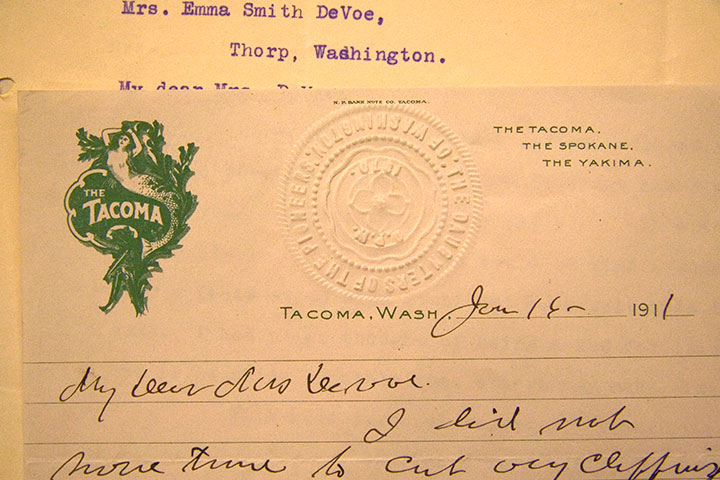
From the documents themselves to the individual script hands of each letter writer, we had an incredible window into political life from a hundred years ago.
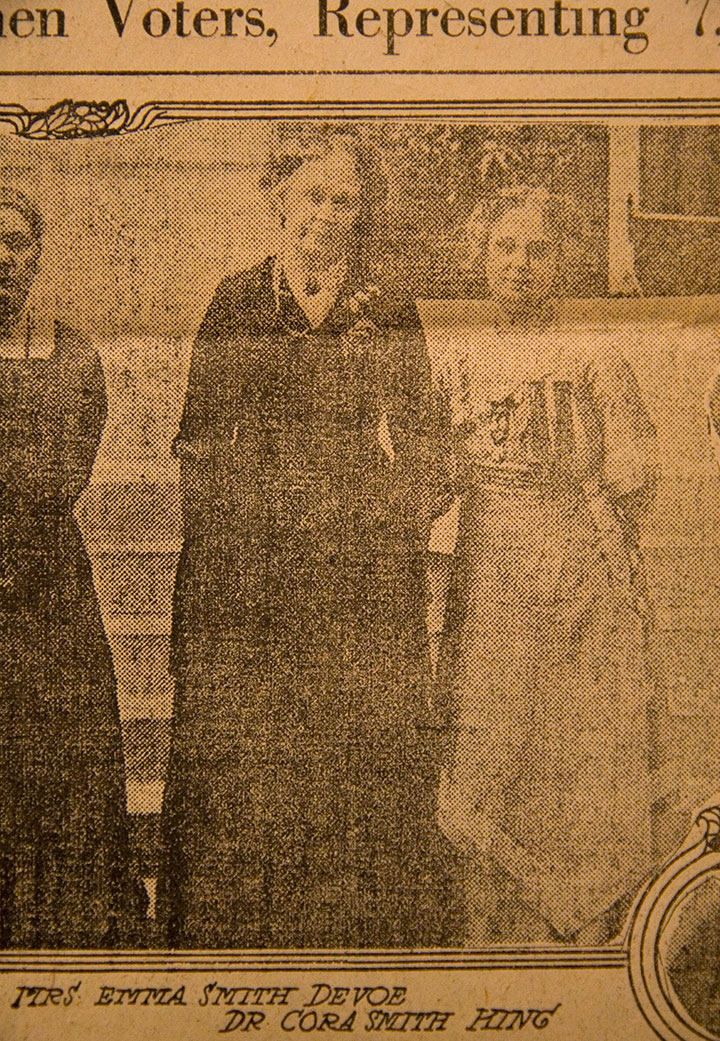
And we found a good lead. Just as interesting as Emma (and more forthcoming with their own voices) were Cora Smith Eaton King, M.D. (pictured above, right)—correspondent, fellow leader of the movement, and one of the first women to scale Mt. Rainier!—and Bernice Sapp—friend, activist, and the one who compiled this collection of documents and donated it to the library.
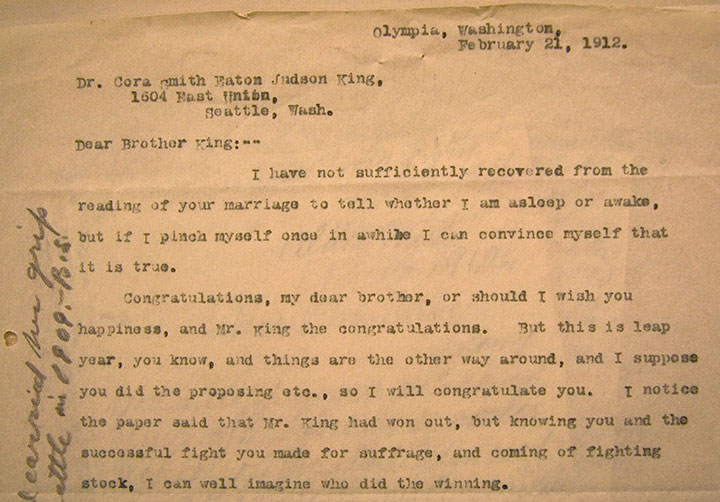
Bernice’s letters were full of quirky character and wit. We loved how she called Emma “the General,” and referred to herself and other suffragists by male titles: “Brother King,” “Mr. Hutton,” or simply “him.”
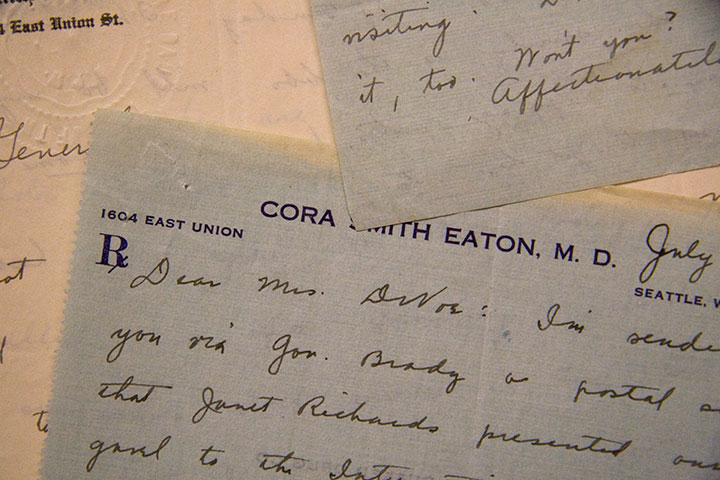
Cora, on the other hand, was a real firecracker. Her letters (often scribbled on scraps of paper, even her own prescription pad!) revealed an eloquent intelligence and a sizzling sense of humor. We fell head-over-heels for Cora, and began to doubt that Emma was the right voice for the broadside—still, though, we had no quote from any of these women.
A few days later, Jessica hit up the astounding Northwest Room at the Tacoma Public Library, and hit the jackpot. She discovered a document that linked all of these women together, which decided us on a slightly different approach to quoting historical feminists. That’s all I’ll say for now, except that the new broadside may or may not depict a certain quivering, questionable “food” substance:

If you want to be one of the first to see what the heck I’m talking about, I invite you to come check out our talk at the Washington State Library. Here are the details:
Pressing Matters: an evening with Chandler O’Leary and Jessica Spring
Wednesday, February 10, 2010
6:30 p.m. (doors open at 6:00), free!
Washington State Library
6880 Capitol Boulevard, Tumwater, WA
Libraries and archives face a tough reality in the current economy—especially here in Washington, where a regressive tax system has left the State Library with a 30% staff reduction and major cuts to its operating and acquisitions budgets. The 2003 earthquake damaged their building on the historic capital campus in Olympia, and forced them to relocate “temporarily” to a suburban office park a few miles south in Tumwater. Even when the economy recovers, it is unlikely the library’s funding will return to the levels it enjoyed in more prosperous eras, so the move to Tumwater is looking increasingly permanent. Despite these setbacks, the State Library continues to acquire new items (including our artwork!) for the collection and provide an essential service in preserving our state’s history. So please come and show your support for the library—a good turnout will help them provide more public events in the future, and might just go a long way toward saving them from another visit to the chopping block.
January 26th, 2010
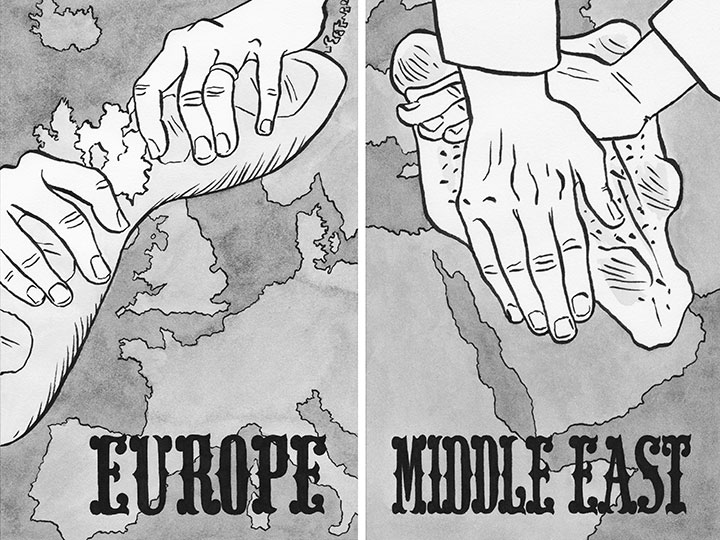
I’m currently working on the illustrations for a cookbook being published this year, so I’m drawing a whole lot of hands lately. Hands carrying dishes, maneuvering chopsticks, folding samosas, kneading dough, etc.

Since I usually work by myself, I often have to be my own model. For the most part, this works out fine, but hands are a tricky business—especially when you need to draw both hands at once, and you need one to operate a pencil.

Enter the lovely Zooey—who could both photograph my hands for me and be hand model herself. We took turns ripping a baguette to shreds for the camera (to mix up the hand anatomy), and mimed with nearly every dish in the house, just in case.
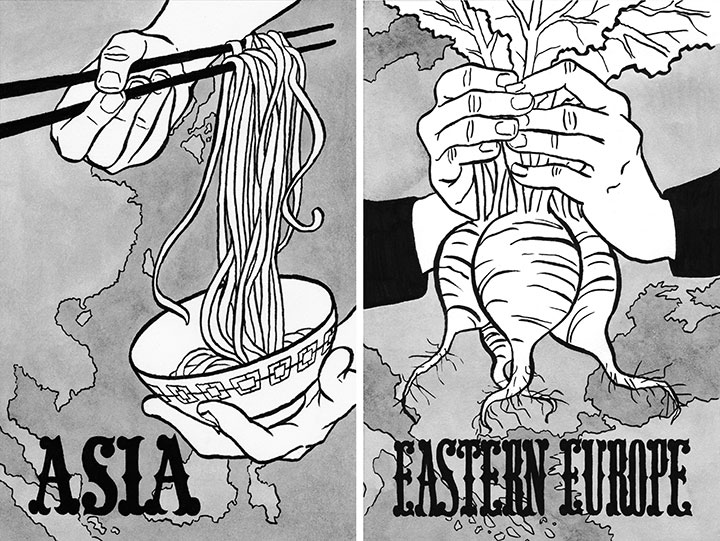
I can’t tell you how helpful it’s been to have her here while I’ve been doing these illustrations. Whenever something wasn’t quite right, I could say, “Hey, Zooey, can you pick up those chopsticks again? I need to sketch a different angle.” And Bob’s your uncle, I’d get what I needed.
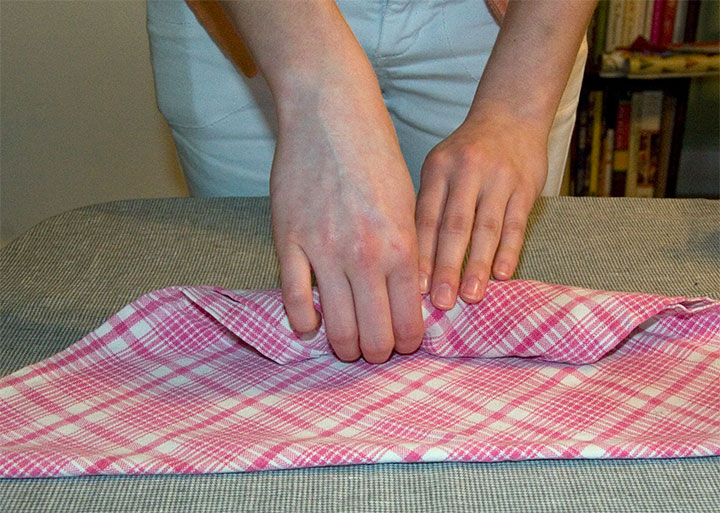
This week we spent a couple of afternoons shooting reference photos. Zooey rolled and unrolled pretend spring rolls made of fabric and made “samosas” with a scrap of denim.
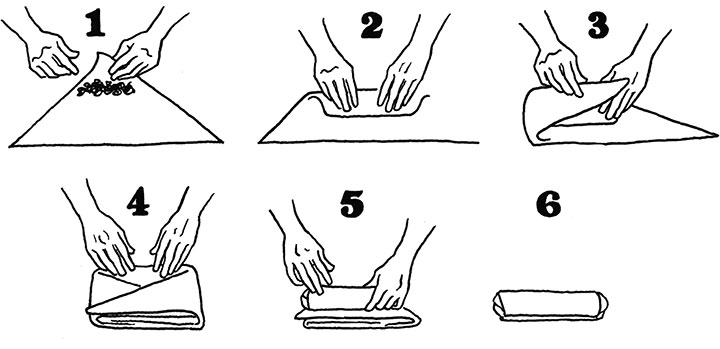
It was probably tedious for her, but the end result was a bunch of instructional illustrations that actually made sense!
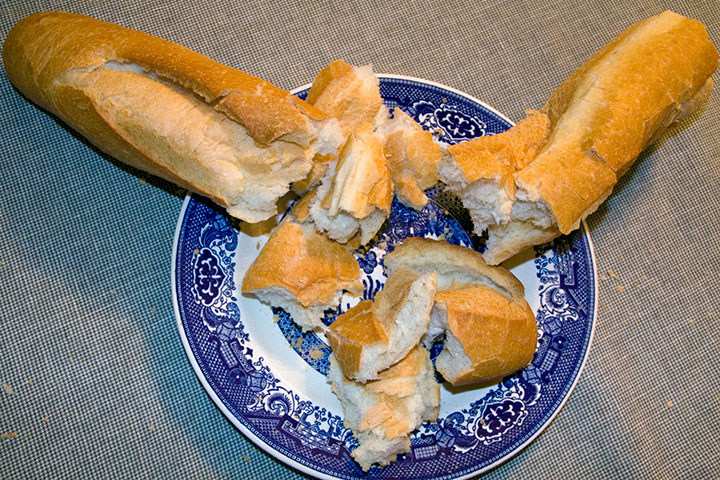
And we made a mess of the bread (doesn’t make it taste any less good!), but Zooey can say she has some pretty, uh, unique on-the-job training under her belt.
• • • • • • • • • • • • • • • • • • • • • • • • • • • • • • • • • • • • • • • • • • • • • • • • • • • • • • • • • • • •
In other news, I did a little website tweaking over the weekend, and added an F.A.Q. (it makes me giggle to pronounce it “Fack.”) If you ever wondered what I mean about half the things I say around here (and judging by the volume of questions I get on a nearly daily basis, you might), go and check it out here—it’s a whopper.
It ended up being a lot of fun to write, because I got to play the part of the snarky interrogator (not that I get many of those, but it’s fun to write like one). I did practice some restraint, however; I was tempted to include a question I get more often than I’d like to admit: “Wait, aren’t you a guy?” True story. Sigh.
Also in the running was “Will you print 1000 coffee mugs with ‘World’s Number One Dad’ for me?” Because I really did get that email once, along with quite a few others mistaking my business for something entirely different. Maybe this will clear things up just a bit…
November 20th, 2009
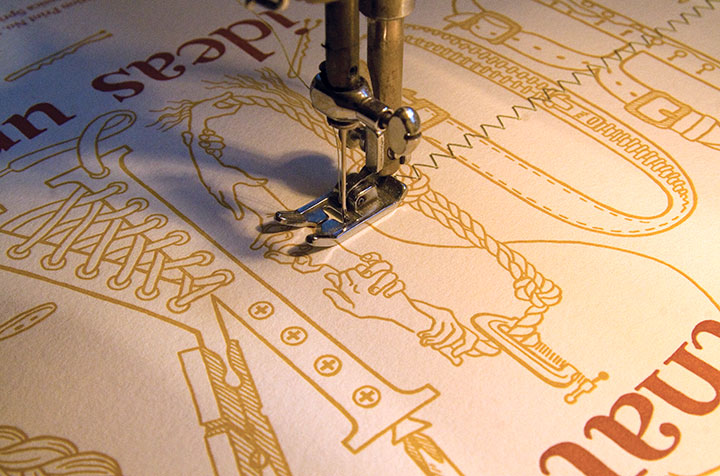
People who stop by the house for the first time must really think I’m strange. Never mind our own personal farmers market residing in the attic and root cellar—these days the place looks like the the visual-art equivalent of Willy Wonka’s Chocolate Factory, with snips of paper, rows of identical bird portraits, bright watercolor cakes, brushes and pencils, boxes of envelopes, shipments waiting to go out, and stacks of prints covering every horizontal surface. It certainly gives new meaning to the term “cottage industry.” I guess that’s what happens when you decide to double your inventory right before the holidays.
This week, though, there was a new element to the chaos: the drone of the sewing machine. And now that all the threads are tied off, Jessica and I are finally ready to unveil a little secret we’ve been sitting on for a few months. Seattle Center for Book Arts (SCBA) asked us to create their second-annual Special Edition Print, and I’m happy to report that they’re now available for sale.

Each year the Special Edition Print has the theme of “Unbound,” and the folks at SCBA challenged us to interpret it how we liked. So instead of our customary work with famous quotes, Jessica whipped up a little gem of her own. We started thinking about all the ways something (not just a book!) might be bound or unbound, which led us to visions of lacing, pinching, tying, zipping, braiding, taping, clamping, buttoning, stitching, buckling, hammering, gluing, clipping, lashing and pinning. Which then, of course, gave me free reign to make an absolute, giddy mess of things, and scatter fasteners and notions all over the page. My favorite additions to the drawing, though, are the bread tags. My grandmother had a whole drawer full of them in her kitchen (did she ever use them, or did I just discover the source of my pack-rat tendencies?), and I loved the way they rattled around in there. So Nana, this one is for you.
Everything is hand-drawn and lettered (as per usual), then letterpress printed in copper ink and an ochre color that is precisely the shade of those little Bit o’Honey candies (remember those?). This time, though, we’ve added a little extra goodie: a line of zig-zag stitching in cotton thread, in exactly the green of copper patina. SCBA is the only place to get these prints, so if you’d like to play a little game of Button, Button, Who’s Got the Button, you can get your copy here.
October 14th, 2009
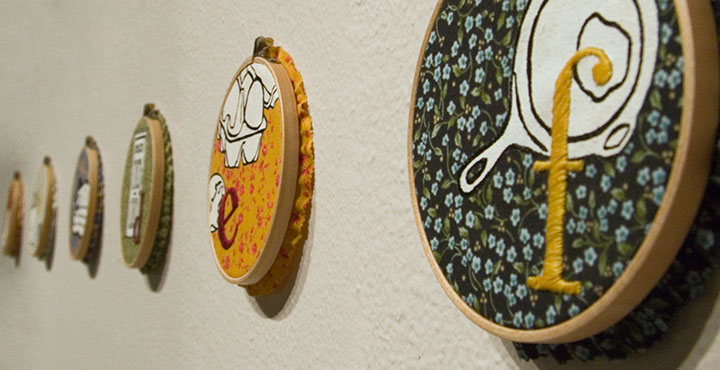
When I walked into the PLU Gallery this morning to document the Mnemonic Sampler show when it opens, my brain had somewhat of a short circuit. Since I was out of town for the past few days, all of the installation work was done for me (thank you a million times over, Heather C.!)—so this was the first time I’d laid eyes on the work since framing it up and chucking the pieces in a box. I somehow couldn’t connect the finished work on the walls with the crazy, chaotic process of the past few months. It seemed so simple, like this was somebody else’s show, and all the nail-biting and never-ending futzing I’d been doing was for some other project that would remain unfinished forever. But I did finish it—and there it is!
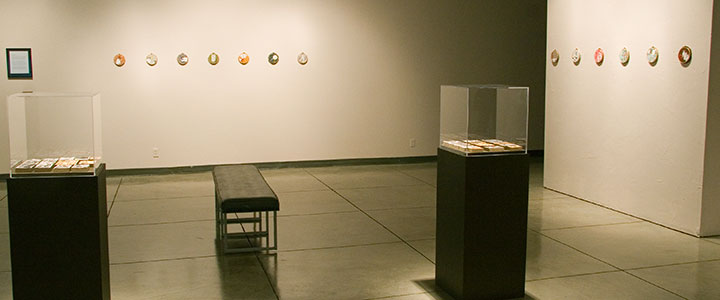
I was nervous about the possible absurdity of having twenty-six small pieces in a colossally huge space, but somehow, it works. Heather ingeniously used lighting and visual breaks to transform the gallery into a space that draws the viewer in and creates an intimate experience—which is exactly what I hoped for. Heather, I owe you big.
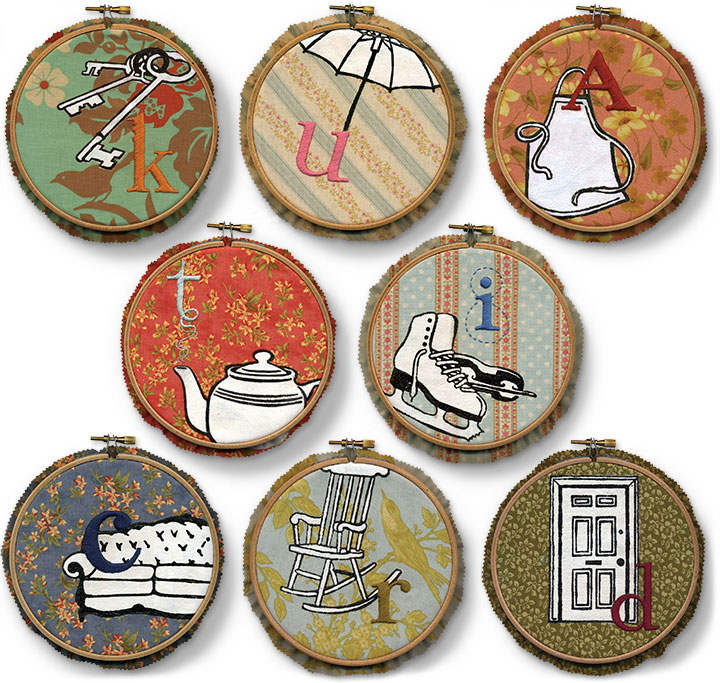
On to the work itself. Here is the artist statement for the exhibit:
The alphabet is one of the first lessons we learn as children. From the beginning we learn to use it as a mnemonic device—just like “Roy G. Biv,” or “Every Good Boy Deserves Fudge”—assigning meaning to our world by associating symbols with each letter. Because the alphabet is one of our most basic and effective memory tools, we are drawn to it as both a visual and narrative archetype. It’s not surprising, then, that the abecedary is somewhat of a staple among book artists.
Just as we use our ABCs as a memory aid, our possessions help us create the concept of Home. No matter what our economic station, living situation, or domestic permanence, we all tend to share similar symbols of comfort and nostalgia. These ideals are embodied in the everyday objects around us—those mundane materials we take for granted, yet without which we would sense something lacking. As someone who has never had a picket fence, who grew up in a nomadic military family, and who has lived her entire life with relatively few possessions, the archetypal Home should seem foreign to me. Yet the same mnemonic triggers exist in my mind; the same objects attract me.
Mnemonic Sampler collects and files our household icons, gathered together like the stitched and quilted samplers of our mothers and grandmothers. The hand-stitched alphabet enumerates my, your, our trappings, shuffling our collective domestic inventory like the old card game of Memory. Each symbol is familiar; each object is Ours, whether we actually possess it or not. Together they sketch out a Home—real or imagined; longed-for or spurned; past, present, or future.
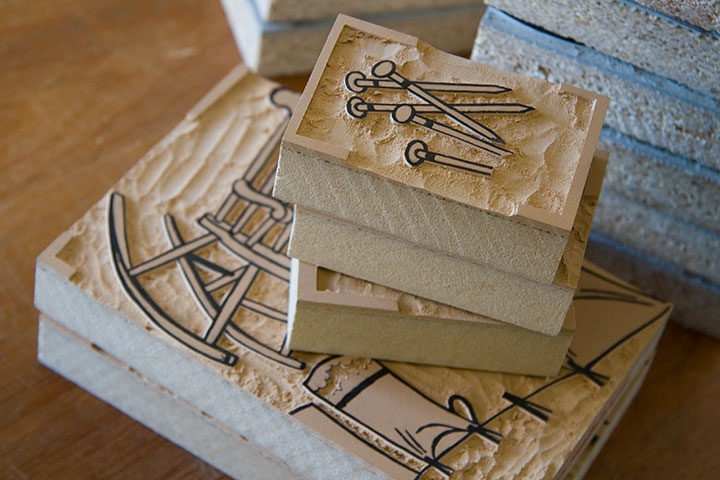
Mnemonic Sampler is a collection of monoprints, which means that instead of an edition of multiples, each print is created in such a way that it can’t exactly be reproduced. This technique results in a one-of-a-kind, totally unique piece—and is often more closely related to painting than printmaking. These pieces are printed from reduction-cut linoleum blocks—meaning both print colors are carved from the same block.
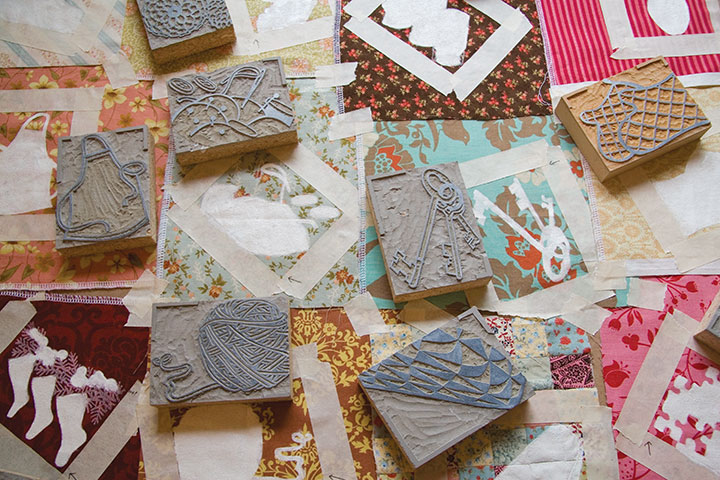
So once the second design is carved, the first color cannot be printed again.
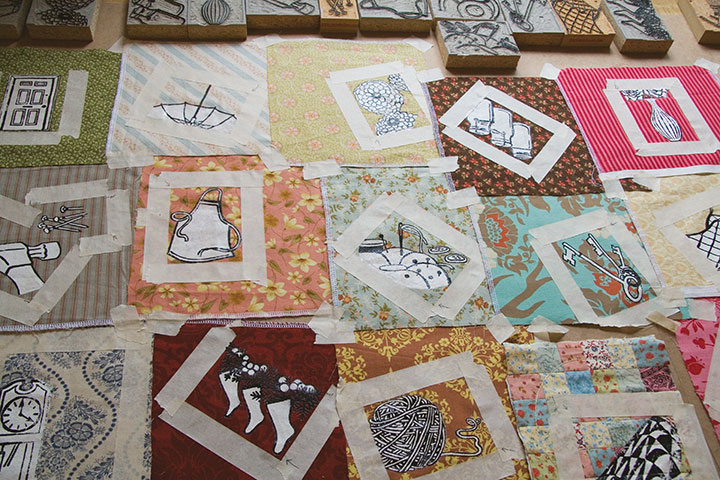
Designing these pieces was an intuitive process, consisting of both logical and intangible choices of fabric and pattern compositions. Because the design stage was so fluid (almost semi-conscious at times), it really wasn’t possible to do the printing on a press. Instead, each impression was made literally by hand, using masking tape to aid in color registration.

“Q” has an extra conceptual level, since the fabric background is a patchwork “quilt” in its own right. Like everything else about the series, the patchwork is sewn by hand, using the English paper piecing technique.
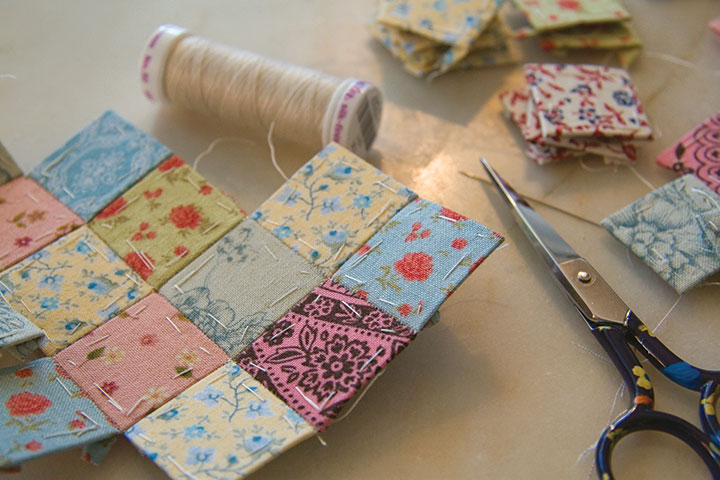
This was my first attempt at paper piecing, and I’m pleasantly surprised at how quick and accurate it is. Instead of folding and ironing every tiny piece, then wrangling a sewing machine, each patch is wrapped around a paper template and basted down, then whip-stitched together into a block.
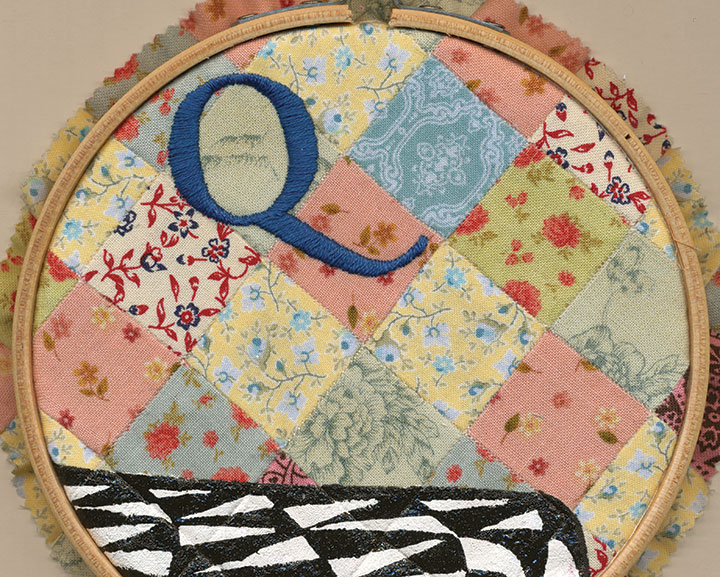
The result is a precise little quilt—perfect for embroidery.
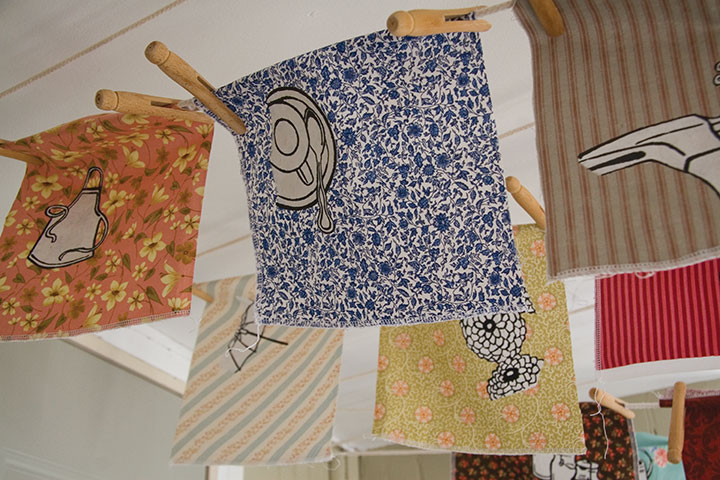
I can’t believe how long it took to complete every step of the process—and yet how quickly everything came together at the end. So you can bet I’m excited about celebrating at the opening tonight. And besides, I’m interested to see if the household objects I chose will resonate with viewers; it wasn’t easy to narrow things down to twenty-six letters of the alphabet, so I picked those objects that had the most meaning for me.
So how about it—what spells “Home” for you?
September 22nd, 2009
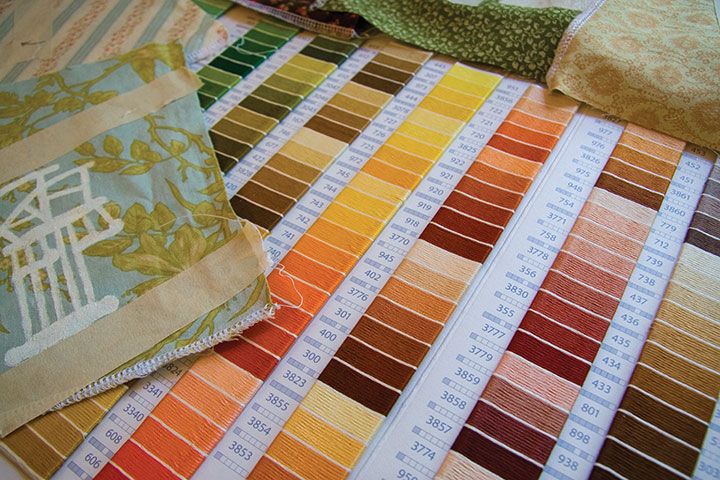
Swatch books are very near the top of my list of Favorite Things Ever. There is something so satisfying about having every color, pattern, texture, or finish right at your fingertips. I love sitting at my table, with a cup of tea in hand and six hundred sample chips spread out before me, ready for some serious color theory. (In case you’re wondering, this is the amaze-a-crazy DMC embroidery floss über color card. Well-made swatch books like this tend to be expensive to produce, and impossible to find once they go out of print. So if you’re into this sort of thing, I’d suggest snagging your copy before they decide to quit selling them.)
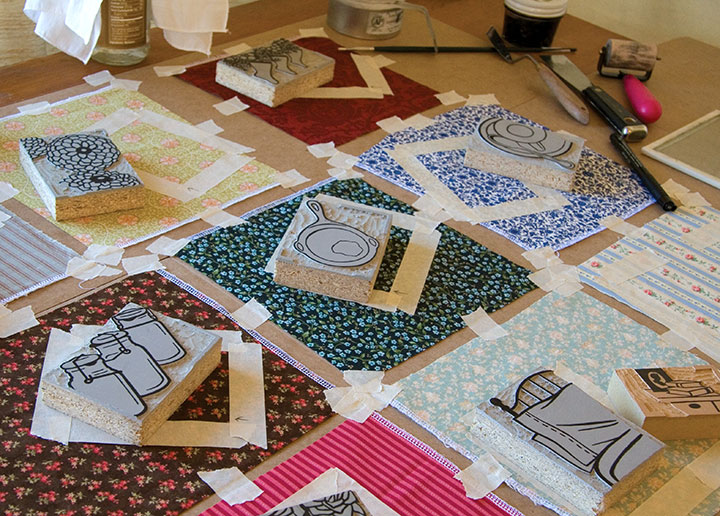
These days the studio has been an explosion of choices. Snippets of fabric and open dictionaries have taken over my life as I get ready for a new solo show, which opens October 14 at the Pacific Lutheran University Gallery. Stay tuned for more details in the next few weeks.
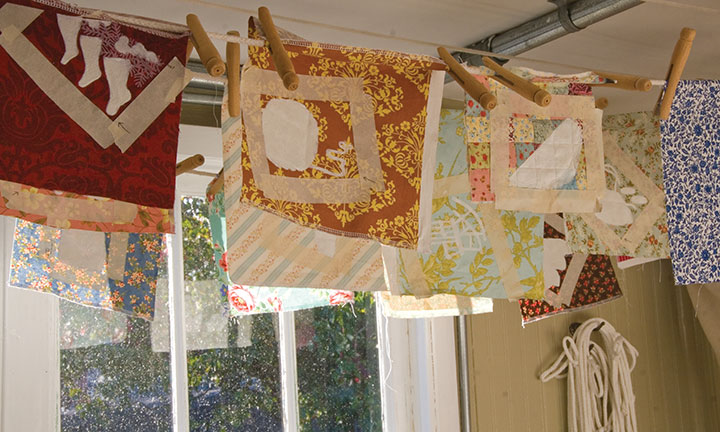
I wish I had something more concrete to show you, but this is one of those projects where everything comes together at once, right at the end (which can be as nerve-wracking as it is rewarding). I’ve got to say, though, that calico—finished or not—sure makes for pretty pictures.
August 12th, 2009
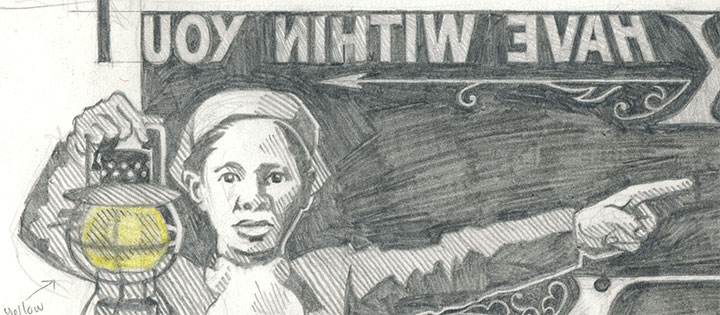
Jessica and I are almost ready to unveil the next Dead Feminist broadside! The ink is drying as I speak, so End of the Line will be available this Friday, August 14. For now, this is just a taste. Brush up on your mirror-reading skills, because this one is going to be a challenge. Stay tuned!
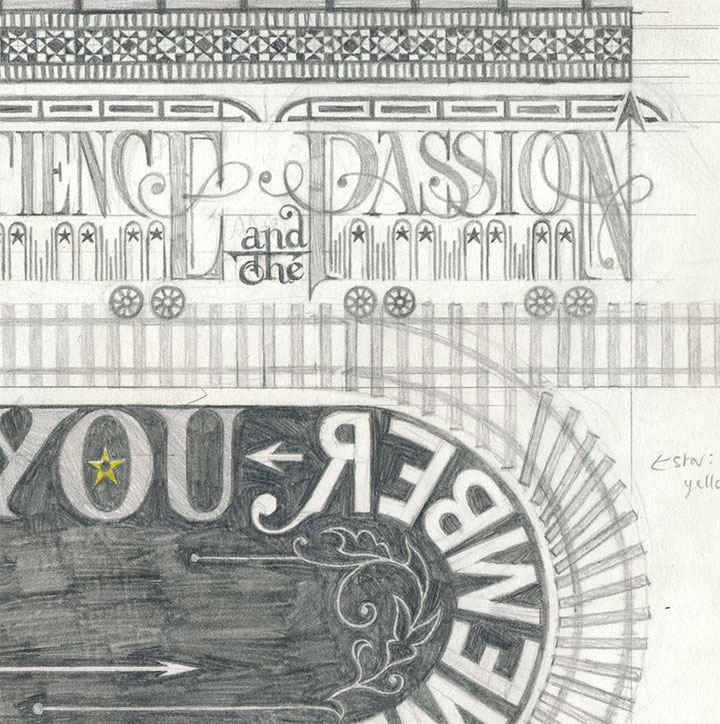
June 21st, 2009
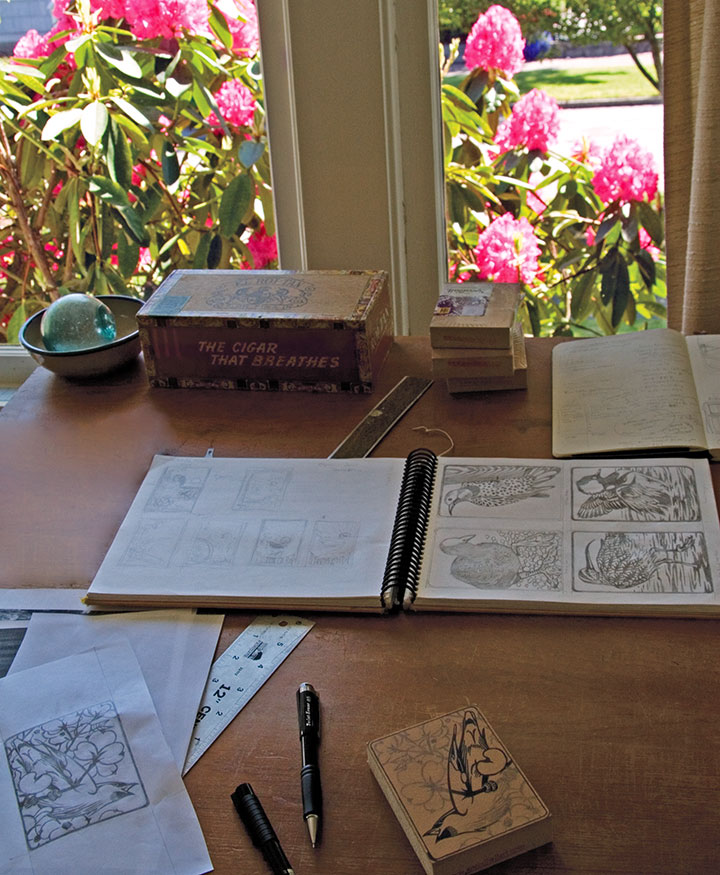
There’s some serious gear-shifting going on in the studio these days. Prop Cake and Tugboat Thea are sold out, and the Woolworth Windows murals are white walls again, ready for the next artist to transform the space. I’m preparing to teach a letterpress class at the School of Visual Concepts next month, and I’m working on a new artist book (more on that topic later). I feel like I’m in that tiny, transitional moment between exhale and inhale.
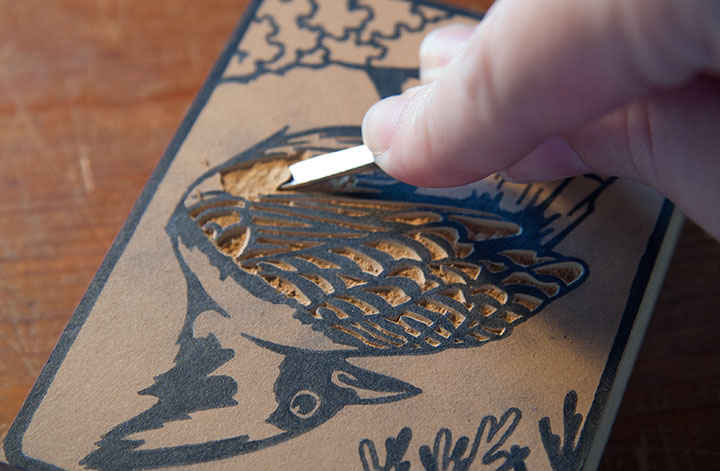
So what better way to use that breath of time than to slow down and do some carving?
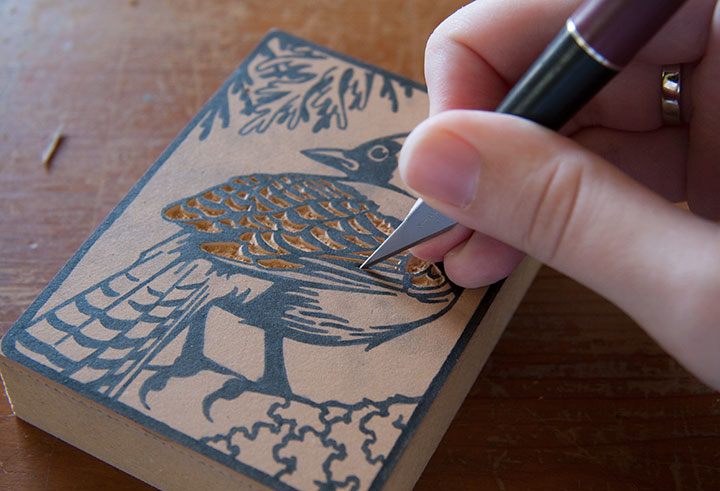
In the free moments between my other projects, I’m also working on a new print series that’s got me all a-flutter.
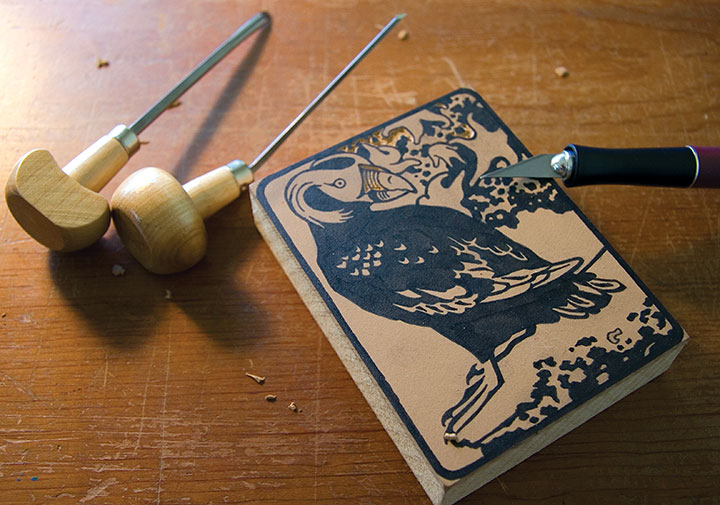
I love getting back to basics, and enjoying the simple mechanics of drawing, carving, and printing images. No fancy photopolymer plates this time—just ink, paper, watercolor, and good old-fashioned linoleum blocks.
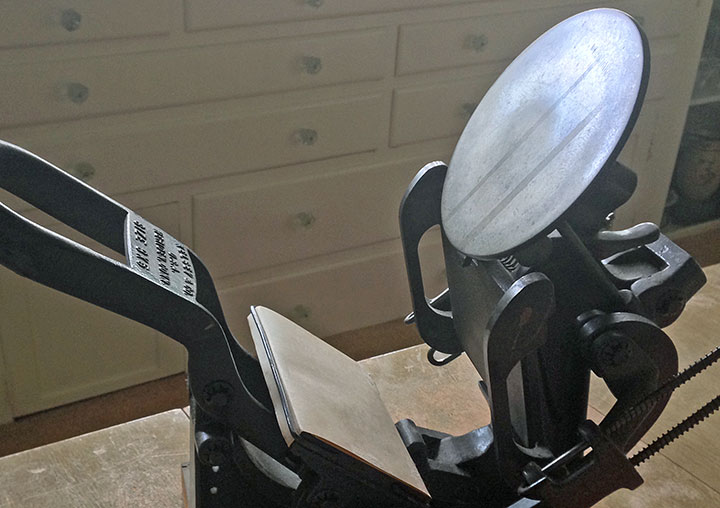
What started as an excuse to get my little Kelsey tabletop press in working order—
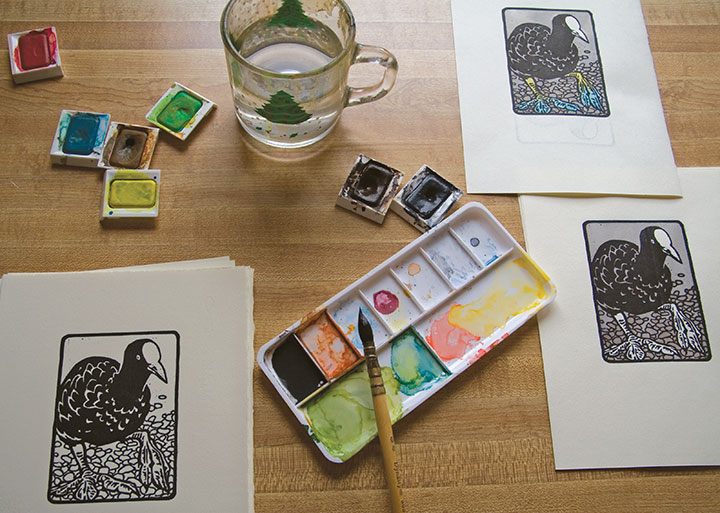
—has turned into a budding interest in birding. There is a stunning array of avian wildlife in my state, and I’m only creating a tiny illustrated cross-section of what’s out there.

The suite tweet of prints is called Flock, and the first nine are currently on display at the Rosewood Café in Tacoma until July 31.
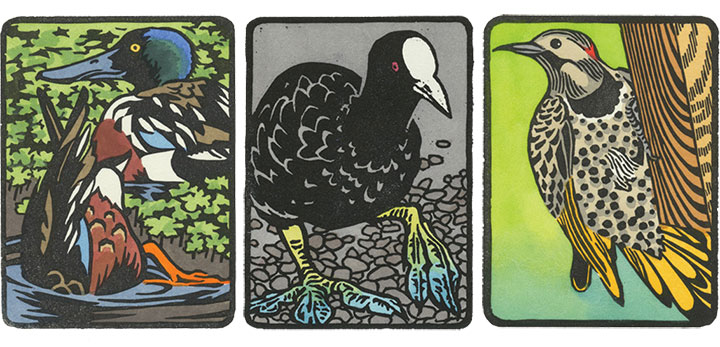
Here’s a closer look at ’em.
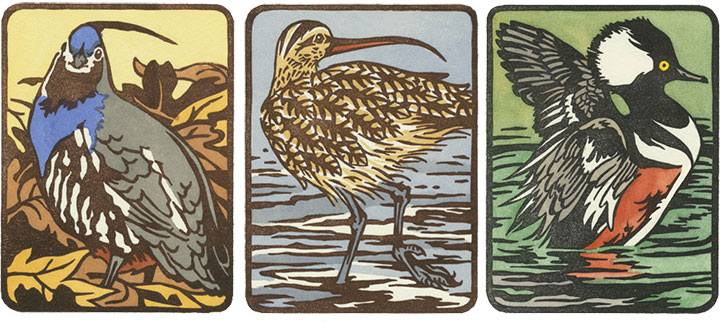
Each print is a hand-colored linocut, printed in an edition of 25. There will be 25 birds in all, and at the end of the series, there will be ten handmade boxed sets—each containing all 25 birds.
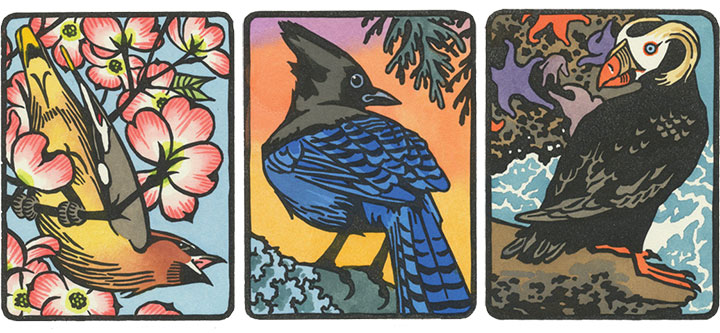
I’ll be printing the rest of the birds in the coming months, and the Flock box sets will be finished sometime next year—eight of the ten sets are spoken for already, but if you’re interested, feel free to drop me a line. I’ll just be here in the studio, happily chirping, cawing, quacking, and twittering away.














![Chandler O'Leary [logo]](https://chandleroleary.com/wp-content/themes/chandleroleary/images/logo.png)
































































